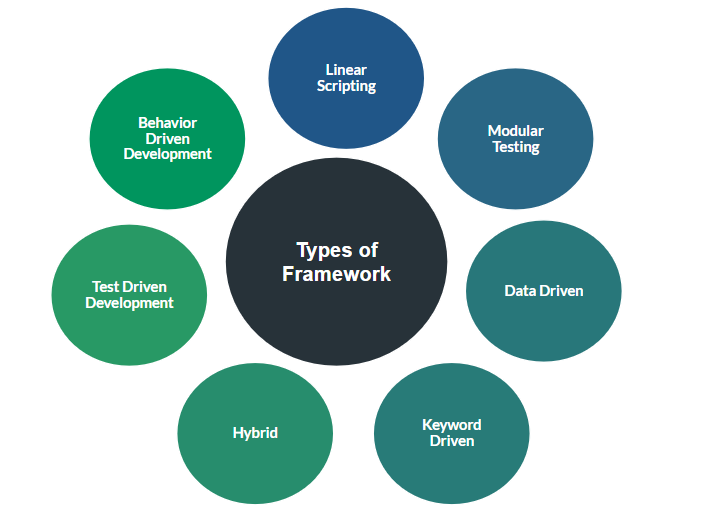In the dynamic world of software development, the role of testing has become increasingly pivotal in delivering products that are not only high-quality but also add value to the end-user. Quality assurance is a cornerstone in the software development process, paving the way to a defect-free, performance-optimized application, one that sometimes exceeds end-user requirements.
However, with the accelerated pace of development and continuous influx of requirements, manual testing becomes unscalable. It is here that automated testing steps in as a solution, complementing, not replacing, the manual testing process by:
- Enabling the automation of repetitive and frequently occurring test cases.
- Allocating time and resources more judiciously to focus on critical or complex test scenarios.
Understanding Test Automation Frameworks
A Test Automation Framework is like a game plan or a rulebook that helps teams conduct software testing in a more organized and efficient way. It’s a collection of guidelines, tools, and methods that are combined to make the testing process smoother.
This framework is created by bringing together different computer hardware and software tools, all working based on certain agreed-upon rules. This setup makes it easier to create and use automated test scripts, helping to find and analyze problems or bugs in the system or application being tested (known as AUT).
In simpler terms, this framework helps testers in a few important ways:
- It helps to quickly find and organize specific parts within a system (like buttons or fields on a webpage) so that they can be tested and reused in different test scripts.
- It allows for certain actions to be performed on these parts, like clicking a button or filling in a field, and then checking to see if the expected results occur.
- It’s a space where automated tests can run smoothly, supported by a set of agreed-upon ideas and practices that guide the whole automated testing process.
In essence, this framework makes the whole testing process less complicated and more effective, saving time and ensuring a higher standard of quality in the final product.
The Essential Role and Benefits of a Test Automation Framework
A well-rounded Test Automation Framework aims to:
- Maintain uniformity across different test scripts with a structured development approach.
- Boost efficiency during the script development stage by encouraging the reuse of components or code.
- Allow for reliable bug identification and thorough analysis with minimal human input.
- Reduce the need for manual input in test execution and suite selection once set up.
- Adjust the testing scope on the fly, responding to changes in testing strategies or conditions.
- Optimize the use of resources, ensuring maximum gains from the efforts invested.
- Ensure a smooth and uninterrupted automated testing process with minimal staff involvement.
Why Opt for a Robust Test Automation Framework?
In today’s fast-paced tech environment, having a well-planned Test Automation Framework is like having a dependable roadmap for building and arranging test cases. These guidelines are the backbone of the automation process, helping testing teams use their resources wisely and effectively. Moreover, they assist in putting together test suites by combining various automated tests, getting them ready for action right away.
By adopting a skilled test automation framework, companies can speed up the testing process, making it more accurate and uniform. This not only improves the return on investment (ROI) but also brings up the quality of the final software product a notch. Hence, picking the right automation framework is a vital step in ensuring the success of application testing.
An effective framework helps in navigating the often complex landscape of software testing, letting teams address potential issues with a more detailed and efficient strategy. It encourages a culture of excellence, where quality is continually improved and refined, ensuring that the final product meets the high standards expected in the market.
Thus, choosing a suitable Test Automation Framework isn’t just a choice but a critical factor in the success of a testing project. It sets the foundation for the automation efforts, aligning with the goals of the organization. Making a choice that aligns with the team’s skills and the project’s needs can pave the way for a successful testing journey, resulting in products that set new benchmarks in quality and customer satisfaction.
Exploring Different Frameworks in Automation Testing

1. Linear Scripting
Linear Scripting, also known as ‘Record & Playback’, is quite simple and straightforward. In this approach, scripts are developed sequentially and are generally utilized in small-scale projects. Though it’s quick to start with, maintenance can be a bit challenging as the project grows.
2. Behavior Driven Development (BDD)
This approach bridges the communication gap between technical and non-technical stakeholders through the use of natural language that describes the behavior of the system. BDD encourages collaboration and focuses on delivering software that truly meets the user’s expectations and business objectives.
3. Modular Testing
In the Modular Testing framework, the application under test is divided into several modules or units, each of which is tested independently. This separation allows for better organization, easier maintenance, and reusable code, which can be a time-saver in the long run.
4. Data Driven
Data-driven testing separates the test scripts from the test data. It allows us to test the application with various sets of data values without scripting individual tests for each data set. This way, a single test script can validate numerous scenarios, making the testing process more robust and efficient.
5. Test Driven Development (TDD)
TDD is a technique where test cases are developed before the actual code. It follows a rapid cycle of writing tests, developing the necessary code to pass the tests, and then refactoring the code to meet acceptable standards. This approach ensures every piece of code is tested and encourages simple and robust code design.
6. Hybrid
A Hybrid framework is a blend of features from various frameworks. This model is adaptable and can be tailor-made to suit the unique needs of a project. It harnesses the strengths of multiple frameworks, providing a flexible and potent approach to automation testing.
7. Keyword Driven
In this framework, test cases are created with a series of keywords representing actions to be performed on the application. This approach allows non-programmers to write test scripts, fostering wider team participation and collaboration in the testing process. It separates the programming code from the actual test case, making script maintenance easier.
Major Advantages of Automation Frameworks
Automation frameworks bring several benefits to the table, including:
- Speeding up the time-to-market with ongoing execution of automated test scripts.
- Expanding scalability opportunities.
- Reducing operational expenses.
- Accelerating the release of high-quality products.
- Surpassing manual testing in performance efficiency.
- Cutting down long-term maintenance costs, despite a higher initial investment.
- Offering cost-effectiveness by facilitating reuse in similar future testing endeavors.
- Providing detailed reports on defect management.
Harnessing the Future: The Next Steps in Automation Testing
Many independent software testing service providers of the next generation have crafted fully operational test automation frameworks that are ready for quick implementation to ensure swift and ongoing releases. Clients can capitalize on these proven solutions to fast-track the market entry of quality software products and applications.
For any further queries or information, don’t hesitate to reach out or visit our Testing Center of Excellence.

